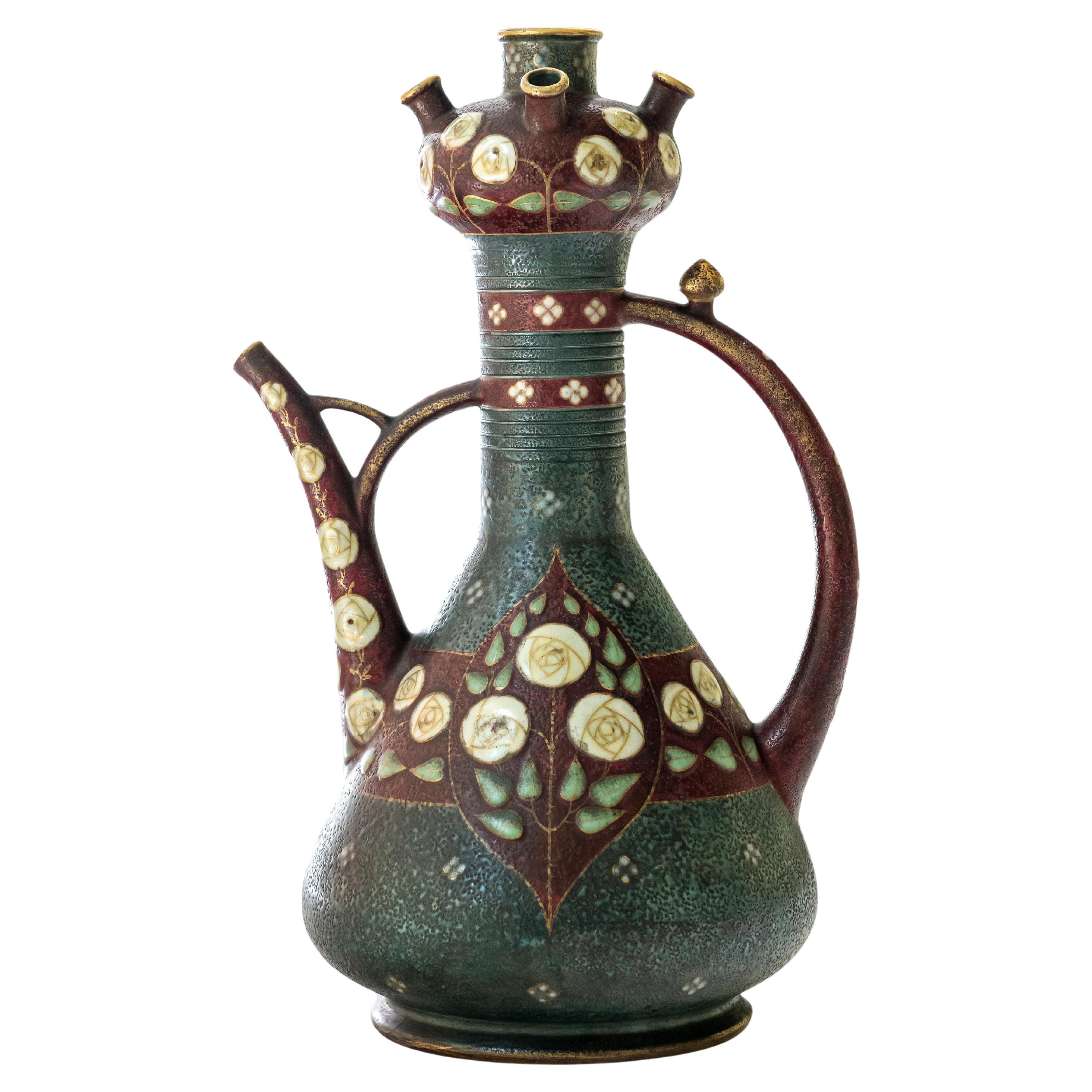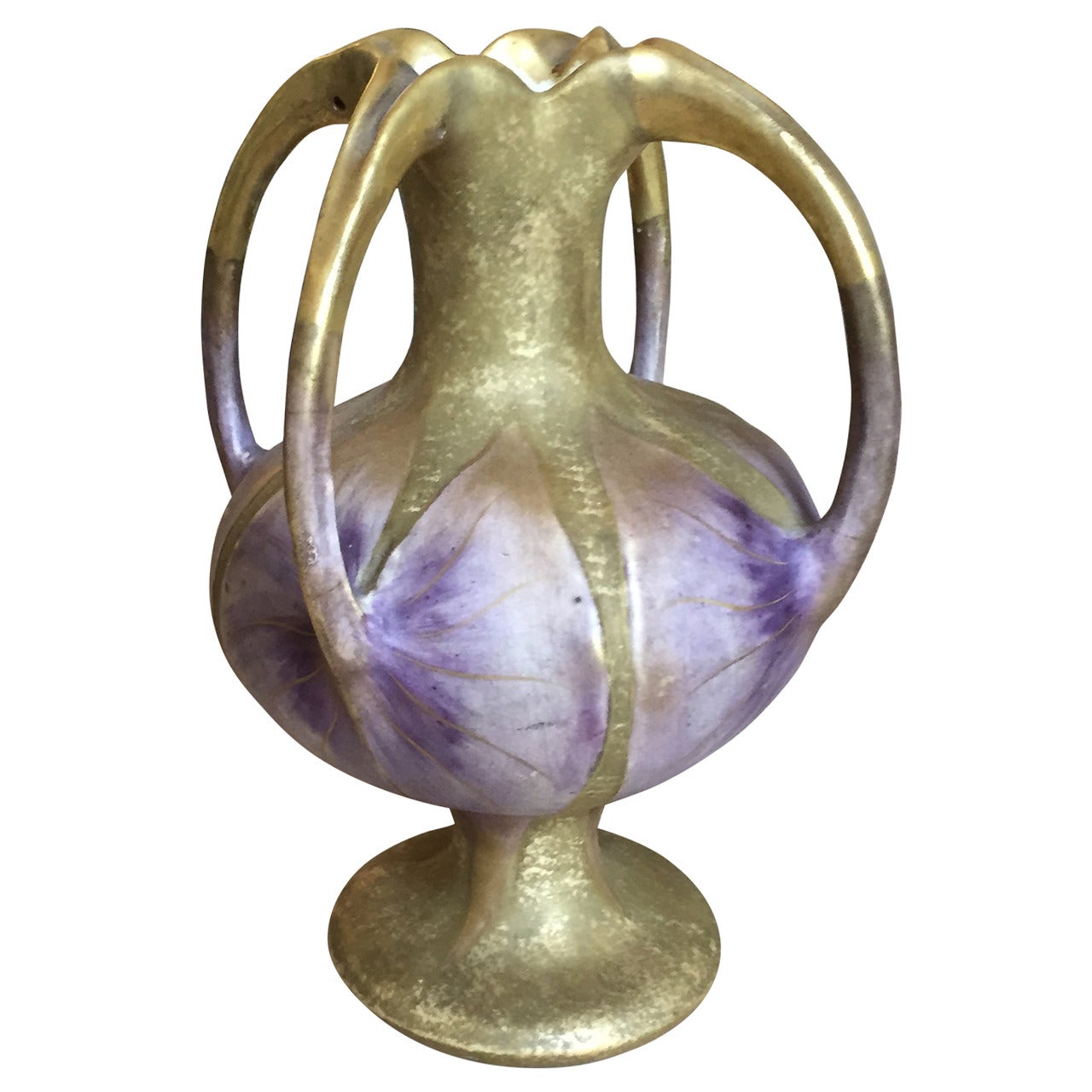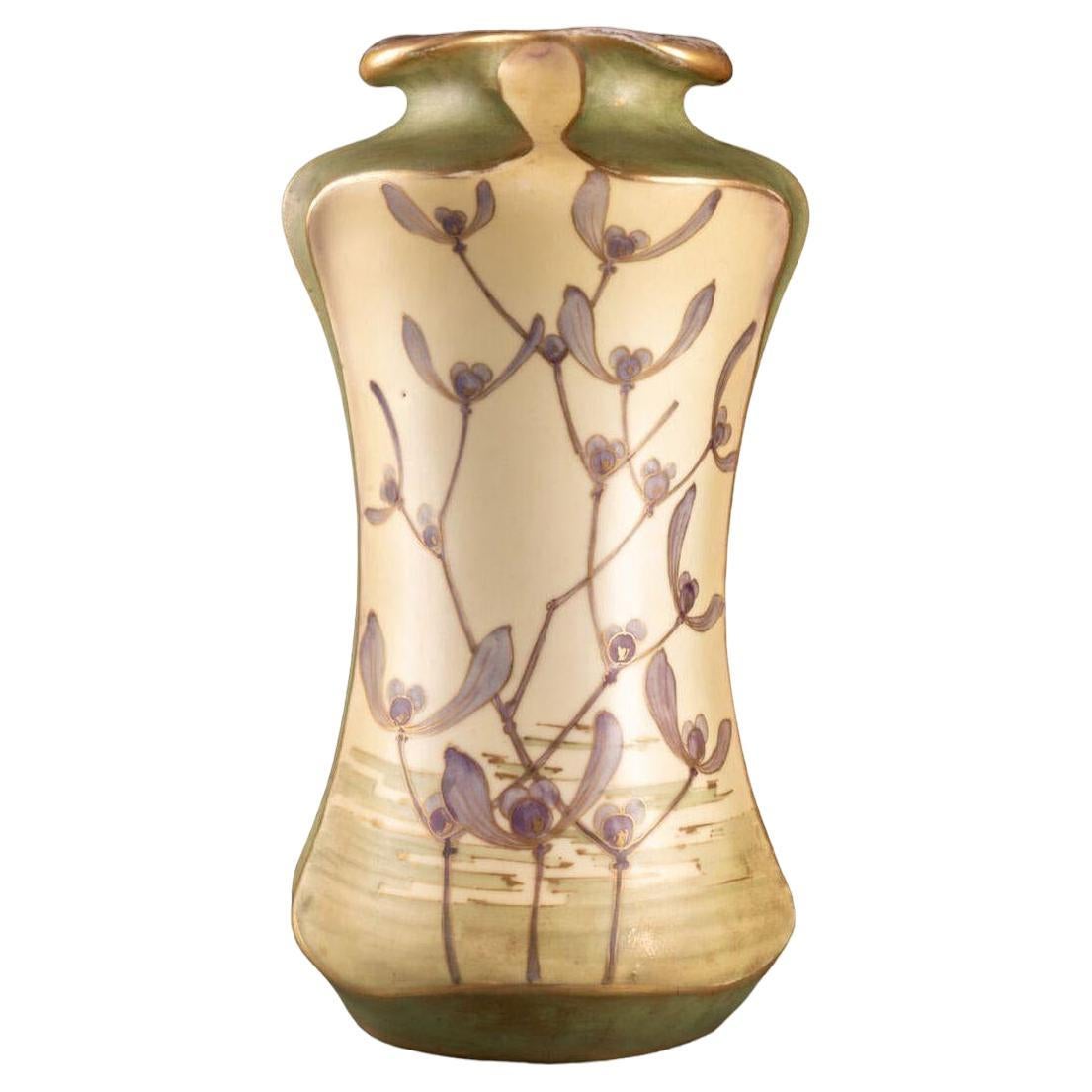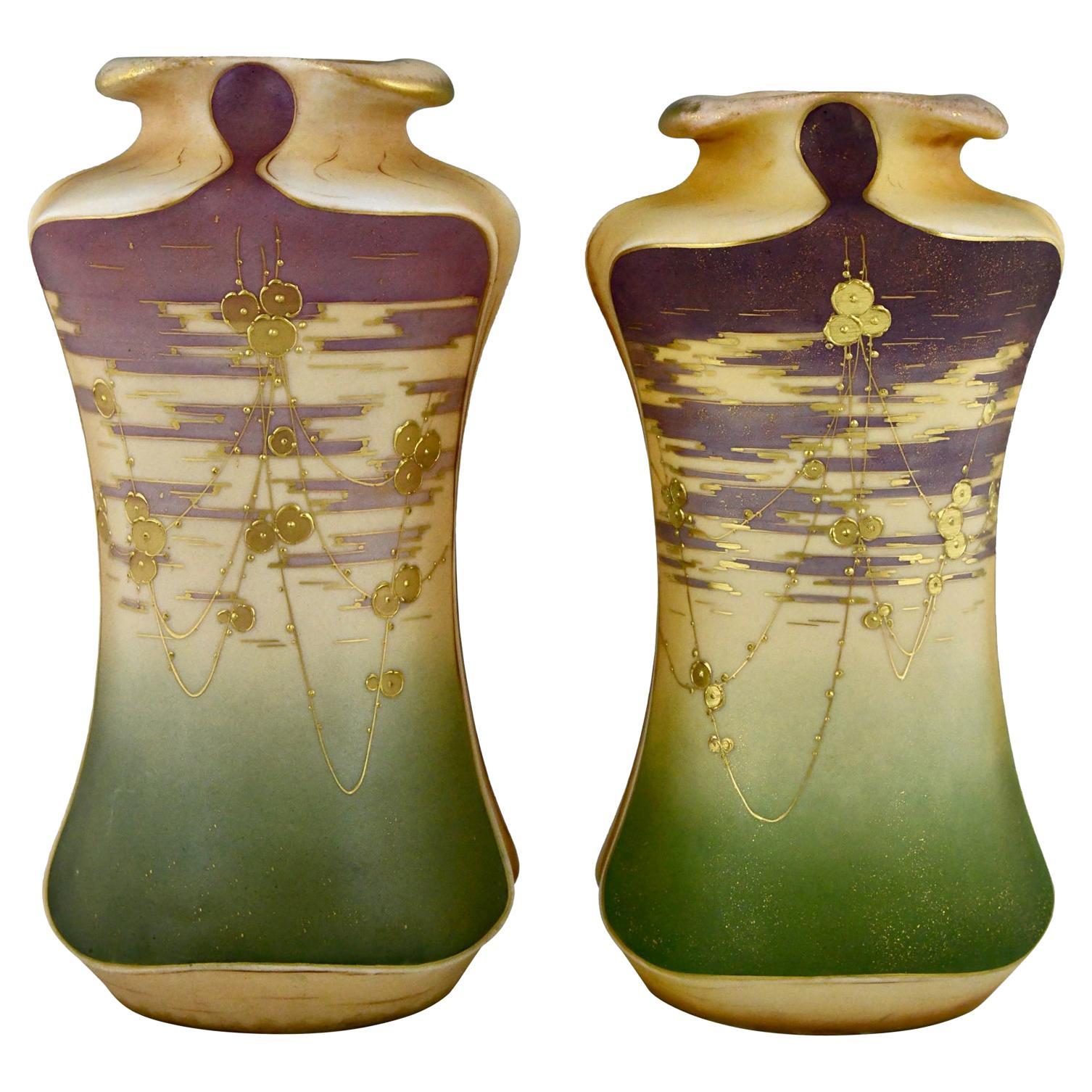Items Similar to Paul Dachsel for Turn Teplitz, Austrian Jugenstil Ceramic ‘Fern’ Vase, ca. 1900
Want more images or videos?
Request additional images or videos from the seller
1 of 9
Paul Dachsel for Turn Teplitz, Austrian Jugenstil Ceramic ‘Fern’ Vase, ca. 1900
About the Item
DETAILS:
Fully marked on bottom.
DIMENSIONS:
height: 6.75 inches, width: 4.5 inches, depth: 4.5 inches
ABOUT THE ARTIST
Paul Dachsel (Czech, born circa 1880) was the son-in-law of Alfred Stellmacher, the founder of Amphora Pottery company in Turn-Teplitz, then in Austria. Very little is known or was written about Dachsel. He served as a designer at Amphora from 1893 until 1905. There, he was instrumental in creating new motifs and designs inspired by the voluptuous, organic Art Nouveau style, as well as incorporating Japanese shapes, such as the sake bottle, to a traditional Victorian vase body. Very soon, most of the vases had converted to Art Nouveau in shape and decoration. In 1905, Dachsel founded his own pottery studio, Kunstkeramik Paul Dachsel. He continued to draw inspiration from Art Nouveau and created designs that favored simple forms elaborated with applied handles, rims, and ornaments. In many examples, he favored tertiary colors and folded, flat, and soft-edged shapes, giving his work a fairy-tale quality. Dachsel’s ceramic studio remained in business until 1911.
- Creator:Paul Dachsel (Maker)
- Dimensions:Height: 6.75 in (17.15 cm)Width: 4.5 in (11.43 cm)Depth: 4.5 in (11.43 cm)
- Style:Art Nouveau (Of the Period)
- Materials and Techniques:
- Place of Origin:
- Period:1900-1909
- Date of Manufacture:circa 1900
- Condition:Wear consistent with age and use. We make our best effort to provide a fair and descriptive condition report. Please examine photos attentively, as they are an integral part of the description. Send us a message to request more details or discuss price.
- Seller Location:New York, NY
- Reference Number:1stDibs: LU2819330230792
About the Seller
5.0
Vetted Seller
These experienced sellers undergo a comprehensive evaluation by our team of in-house experts.
Established in 1993
1stDibs seller since 2017
68 sales on 1stDibs
Typical response time: 2 hours
- ShippingRetrieving quote...Ships From: New York, NY
- Return PolicyA return for this item may be initiated within 10 days of delivery.
More From This SellerView All
- Austrian Jugenstil Patinated Bronze Sculpture of Fawn Youth, Ca. 1900Located in New York, NYProbably Austrian, this lovely Jugenstil desk-sized black-patinated bronze figurine on its original marble pedestal depicts a fawn youth, checking the size of his tail to see how muc...Category
Antique Early 1900s Austrian Jugendstil Figurative Sculptures
MaterialsMarble, Bronze
- Austrian Jugenstil-Secessionist Brass Desk Lamp with Glass Cabochons, ca. 1900Located in New York, NYAbout Lamp Rare, museum-quality and unique in its most unusual yet discreet low-key design and the finest workmanship, this Austrian Jugenstil/Secessionist brass...Category
Antique Early 1900s Austrian Jugendstil Table Lamps
MaterialsBrass
- German Jugenstil Silvered Table Mirror, Ca. 1900Located in New York, NYThis grand German Jugenstil mirror in the Secessionist taste features three laconically designed but highly functional sections. The upper section is a large round swiveling pane of ...Category
Antique Early 1900s German Jugendstil Table Mirrors
MaterialsMetal
- Paul Loiseau-Rousseau, French Art Nouveau Gilt Bronze Jug, Ca. 1900By Paul Loiseau-Rousseau 1Located in New York, NYPaul Louis Emile Loiseau-Rousseau (French, 1861-1927) was a famous French sculptor. In his youth, he planned to devote himself to etching, was a student of Antoine-Louis Barye at the...Category
Antique Early 1900s French Art Nouveau Vases
MaterialsBronze
- French Art Nouveau Patinated Bronze Sculptural Iris Vase, ca. 1900Located in New York, NYABOUT IRIS The iris is a special and mysterious flower. Not only because of its striking appearance, but also from an artistic and historical point of view. It is also like a work of art, as though created by Mother Nature. The unique leaves of this plant not only create wonderful shadow casts, but also look as if they were painted by hand. It's no wonder that iris acts as the muse for countless artists, and can be seen in many famous works of art. The iris was first spotted in the time of Pharaoh Thutmose, in 1504 BC. He had the iris inscribed into the wall reliefs of a temple as a sign of his power, as well as decorating his sceptre with motifs of the flower. Since then, the iris has been a symbol of victory in Egypt. But the symbolism of the iris goes further than that. In Japan, the flower represents courage and is the symbol of the boys' festival. In Islamic cultures, the iris is a symbol of prosperity. In Europe, the flower was a popular weapon symbol in the Middle Ages and stood for chivalry. And in Christianity, the iris was seen as a symbol of the trinity because of its three-part flowers. With more than 300 varieties, the iris is now the most popular flower among growers and gardeners following the rose. Countless artists use the iris in their works and the flower is present in all eras. You can see the flower on furniture, vases, jewelry, fabrics, sculptures, coats of arms and much more. Did you know that the iris is also called the sword lily? It's not a coincidence that it used to symbolize physical and emotional pain and suffering caused by a weapon. We also see the flower in religious art, where it's often associated with Mary and Jesus. The iris is also associated with the Greek goddess Iris, where the flower symbolizes reconciliation and divine messages. This is also reflected in many paintings. Finally, the iris is also visible in Dutch and Flemish still-life paintings. This can be in a religious form, incorporated into an object or as a decorative flower. In the Art Nouveau art movement, the iris (along with other plants, such as the birch) was often used as an expression of feminine beauty. With its almost otherworldly appearance, the iris is perfectly suited to the Art Nouveau aesthetic and is featured in many well-known works of art. The poet of that era, Hermann Hesse...Category
Antique Early 1900s French Art Nouveau Planters, Cachepots and Jardinières
MaterialsBronze
- After Loetz, Bohemian Jugendstil Iridescent Art-Glass Flower Vase, ca. 1900By Loetz GlassLocated in New York, NYThis large elegant, museum quality flower vase was probably made by Johann LOETZ Witwe Glassworks (Klostermühle, Bohemia, circa 1900) is a superior example of Jugendstil ~ Art Nouveau luxury object. The semi-translucent art glass strikes a spectator not only with the uniqueness of its surface, reminiscent of crocodile skin, but also with unexpected color scheme - a combination of dark brown, old gold and green, covered with craquelure; against the background of iridescent violet. The vase is framed by outstandingly designed bronzed & patinated pewter mounting, consisting of simple large handles, almost geometric-form; with one wreath of leaves, crowning the neck; and the second, forming a base. The simplicity of the forms both, the glass vessel and the mounting are generating extremely interesting decorative effects, inherent exclusively to Jugendstil ~ Art Nouveau era. LOETZ Witwe Glassworks In 1836, Johann Eisner established a glassworks in the Southern Bohemian town of Klostermühle, today part of the Czech Republic. The Art Nouveau Period was the glory years of the company. The glassworks created large numbers of its own new designs of iridescent, trailing art nouveau glass, sometimes in collaboration with well-known artists and designers like Marie Kirschner and Franz Hofstötter (aka Franz Hofstätter). The company’s success during this period had two prime drivers – the technical expertise of Prochaska and the business acumen of von Spaun. Loetz Witwe created many of its own designs, and also supplied glass commissioned by major customers like E. Bakolowits (Vienna) and Max Emanuel...Category
Antique Early 1900s Czech Art Nouveau Vases
MaterialsArt Glass
You May Also Like
- Ceramic Vase Signed Turn-Teplitz, Attributed to Paul Dachsel, Austria, c. 1900By Paul DachselLocated in Buenos Aires, Buenos AiresCeramic vase signed Turn-Teplitz. Attributed to Paul Dachsel, Austria, circa 1900.Category
Antique Early 1900s Austrian Vienna Secession Vases
MaterialsCeramic
- Art Nouveau Vase w/Stylized Trees by Paul Dachsel for Ernst Whaliss Turn-TeplitzBy Paul DachselLocated in Chicago, USPaul Dachsel was the son-in-law of Alfred Stellmacher, the founder of Amphora Pottery company in Turn-Teplitz, then in Austria. Very little is known or was written about Dachsel. He ...Category
Vintage 1910s Austrian Art Nouveau Vases
MaterialsEarthenware
- Paul Dachsel Vase for AmphoraBy Amphora, Paul DachselLocated in Brooklyn, NYDelicate porcelain four-arm vase with lilac flower glaze and applied gilt. Fully hallmarked to underside.Category
Antique 1890s Austrian Porcelain
MaterialsPorcelain
- Large Paul Dachsel Amphora Water Lillies Vase Art Nouveau Circa 1900By Paul DachselLocated in London, GBA Large Riessner, Stellmacher & Kessel large Amphora vase decorated with water lilies; attributed to Paul Dachsel, Turn-Teplitz, Bohemia; c. 1903; n...Category
Antique Early 1900s Austrian Art Nouveau Vases
MaterialsPottery
- Art Nouveau ceramic vase with Birds Flowers by Turn Teplitz Amphora Austria 1900By Amphora Austria ManufactoryLocated in Richmond Hill, ONVASE in a stylized plant shape with a hemmed neck Decor of flowering stems against a backdrop of a lake landscape in reserve Glazed ceramic. Marked on underside Turn Teplitz Bohemia...Category
Antique Early 1900s Austrian Art Nouveau Vases
MaterialsCeramic
- Art Nouveau ceramic vases with gilt flowers by Turn Teplitz Amphora Austria 1900By Amphora Austria Manufactory, Turn-TeplitzLocated in Antwerp, BEArt Nouveau ceramic vases with gilt flowers by Turn Teplitz marked RStK and Amphora. Ceramic, hand-painted green and purple with gilt flowers. Austria c...Category
Antique Early 1900s Austrian Art Nouveau Vases
MaterialsCeramic
Recently Viewed
View AllMore Ways To Browse
Ceramic Austria
Austrian 1905
Antique Fern
Austrian Art Nouveau Vase
Fern Living
Ceramic Organic Shape Vases
Antique Pottery Companies
Black Japanese Vase Antique
Antique Style Draws
1900 Japanese Vase
Austrian Vase Painted
Little Ornaments
Antique Vases From Austria
Edged Ceramic Vase
Antique Japanese Vase Shapes
Ca Pottery
Folded Vase
Black Pottery Vase Japan





